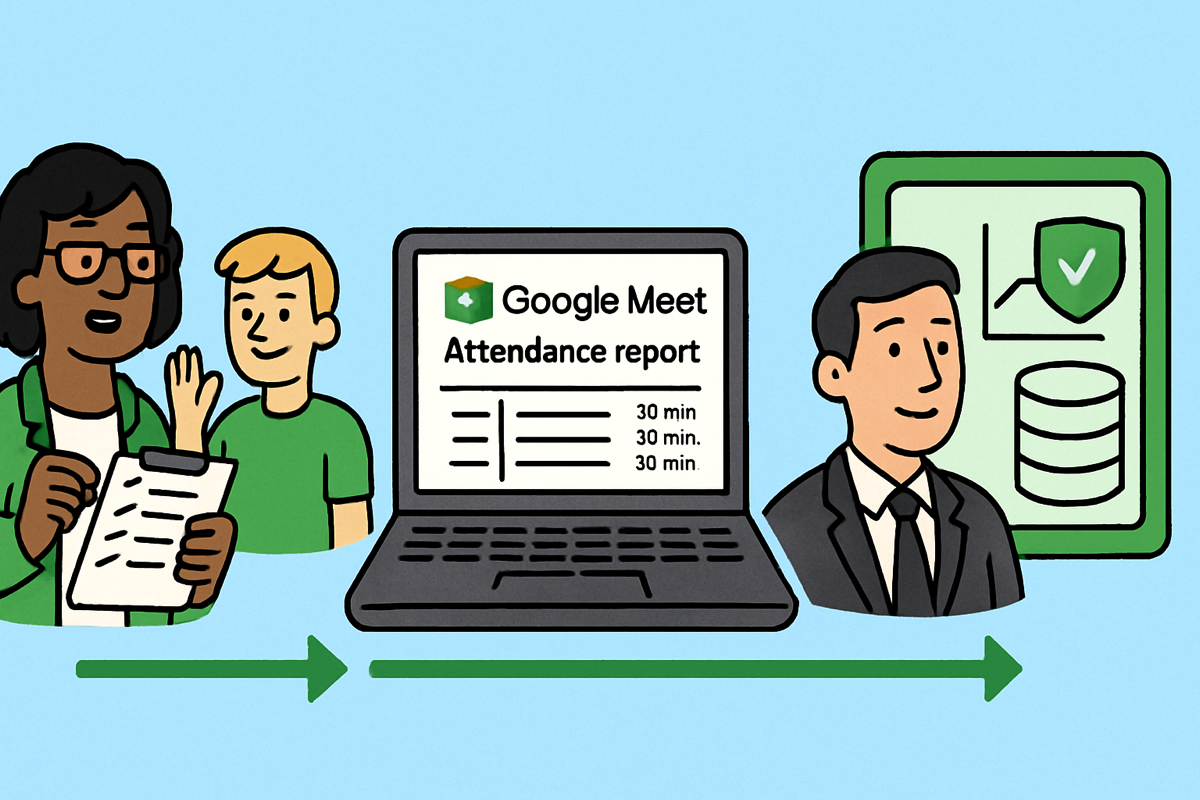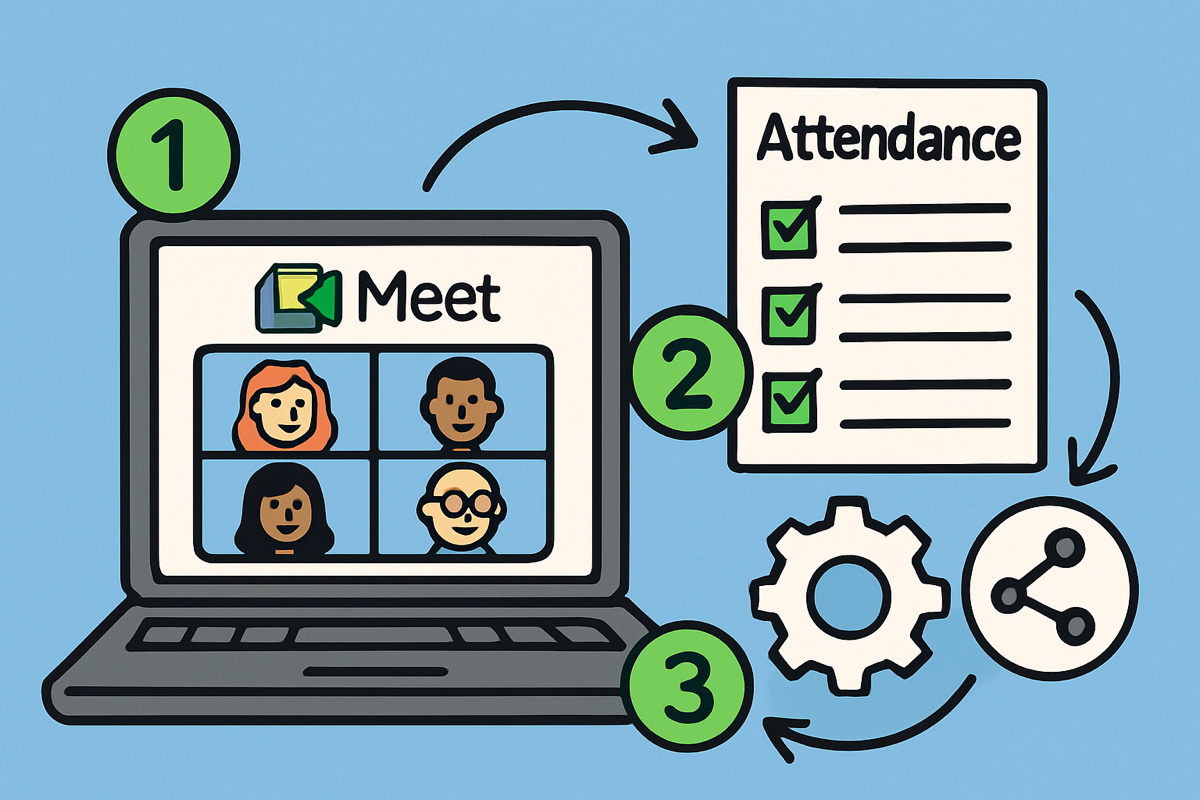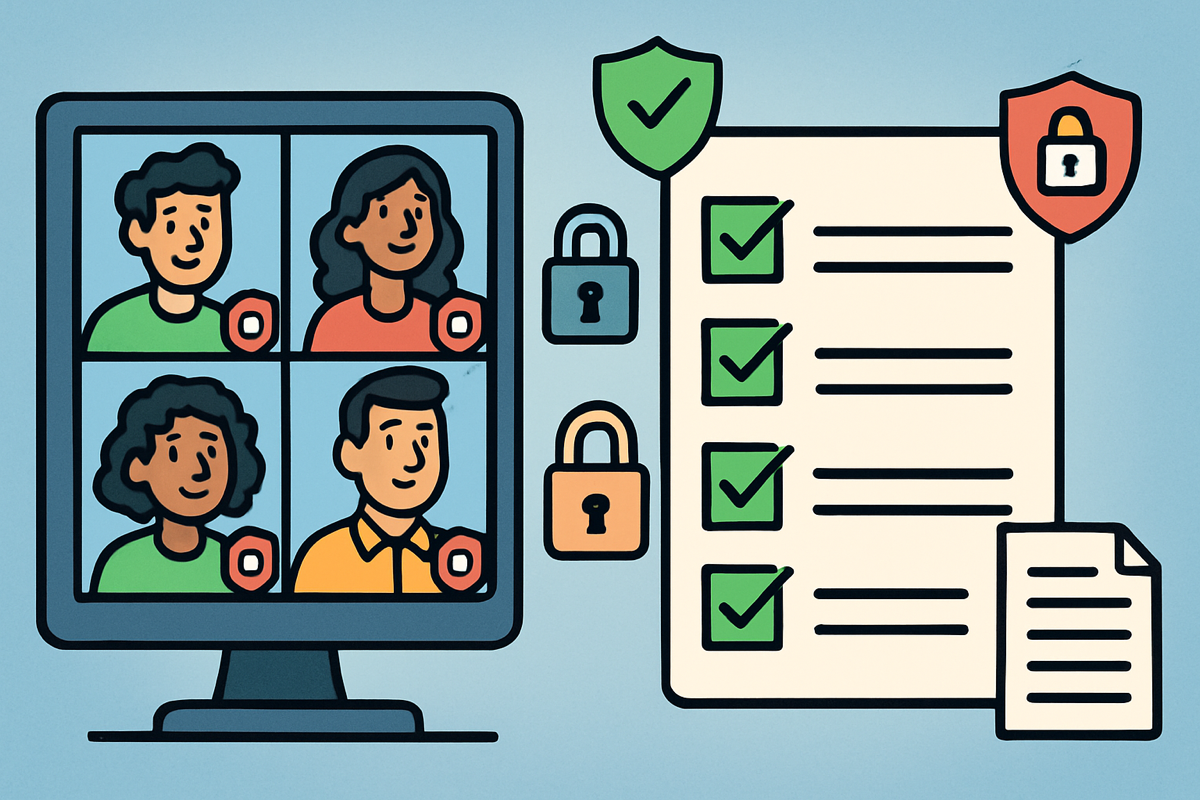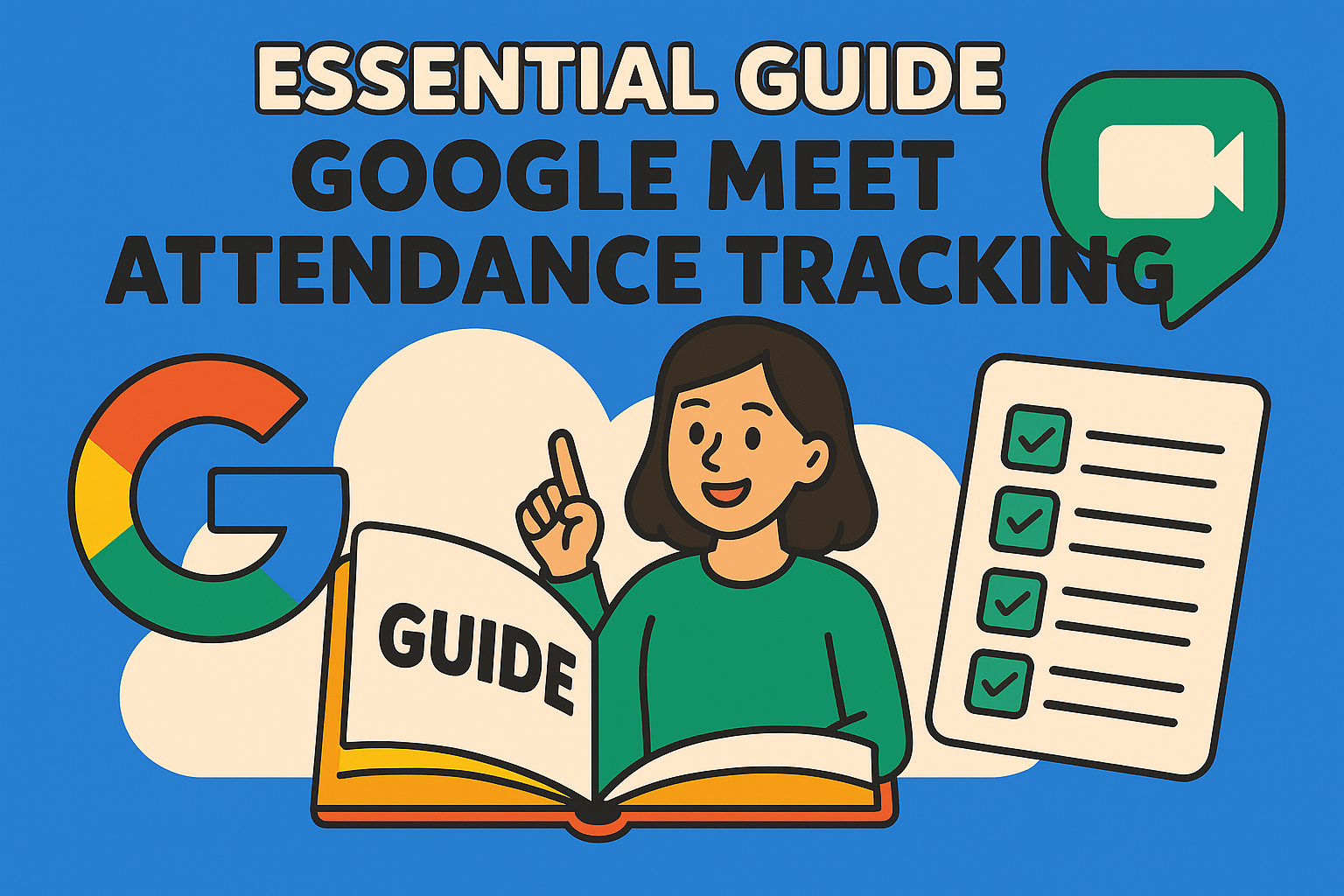As remote meetings and virtual classrooms reshape the way we connect, the need for reliable google meet attendance tracking has never been greater.
Educators, corporate trainers, and organizations often struggle with manual processes that can lead to compliance risks and missed opportunities for engagement.
This guide explores the latest strategies and tools for accurate, secure, and actionable attendance tracking in 2025.
You’ll discover practical step-by-step methods, automation options, privacy considerations, and advanced analytics.
Whether you’re managing a classroom or leading a virtual team, this article is your go-to resource for mastering attendance tracking in Google Meet.
🚀 Quick Start
Ready to start tracking attendance immediately? Download the free RollCall extension and begin automated Google Meet attendance tracking in under 2 minutes.
Add RollCall to ChromeThe Evolution of Google Meet Attendance Tracking
The landscape of google meet attendance tracking has transformed rapidly in recent years. As organizations adapt to new digital norms, the need for efficient, accurate attendance solutions has never been more pressing. Let's explore how attendance tracking has evolved alongside technology, regulation, and user expectations.

The Rise of Virtual Meetings and Classrooms
Since 2020, virtual meetings have surged, reshaping how teams and classrooms operate. By 2024, over 300 million people used Google Meet daily, highlighting its role in connecting remote learners and professionals.
Institutions now require robust google meet attendance tracking to ensure compliance, funding, and engagement. Accurate records are essential for both academic accreditation and workforce management.
Early Methods and Their Limitations
In the early days, google meet attendance tracking relied heavily on manual processes. Hosts would perform roll calls, save chat logs, or export participant lists after each meeting.
- Manual roll calls: Prone to oversight and time delays.
- Chat logs: Difficult to parse and organize.
- Exported lists: Risk of losing data or missing participants.
These methods were inefficient, especially for large groups, and often led to data errors and frustration.
Google's Native Attendance Features
To address these challenges, Google introduced built-in attendance reports for certain Workspace for Education and Enterprise accounts. These reports provide basic information such as participant names and times.
However, the coverage is limited—many users lack access depending on their subscription. The data is also minimal, without engagement metrics. For official details and setup instructions, refer to Google Meet's built-in attendance tracking.
The Need for Advanced Solutions
As digital learning and remote work matured, users demanded more from google meet attendance tracking. There's a growing need for detailed data, including join and leave times, engagement analytics, and trend reports.
Organizations must also meet strict attendance policies, making automated and integrated solutions a priority. These tools help ensure compliance and provide actionable insights.
The Impact of Privacy Regulations
Privacy regulations like GDPR and FERPA have shaped how google meet attendance tracking is approached. Institutions must now prioritize tools that protect participant information.
This shift has led to the adoption of privacy-first solutions, emphasizing local data storage and minimal data sharing. The focus is on balancing effective tracking with strict regulatory compliance.
Step-by-Step: Setting Up Google Meet Attendance Tracking in 2025
Setting up google meet attendance tracking in 2025 requires careful planning and the right tools. Whether you're an educator, HR manager, or team leader, a structured approach ensures accurate records and compliance. Let's break down the process into practical steps for a seamless experience.

Preparing Your Google Meet Environment
Before launching google meet attendance tracking, verify your Google Workspace edition. Only certain versions, like Education and Enterprise, offer native attendance features. Check your account settings to ensure access.
Configure meeting settings to optimize tracking. Use clear naming conventions for recurring sessions, such as "Math 101 – Spring 2025" or "Weekly Marketing Sync." Adjust participant permissions to prevent unauthorized entry or name changes.
Consider setting up recurring meetings for classes or regular team check-ins. This streamlines scheduling and ensures consistent attendance data. Document your setup process in a shared file for reference.
- Verify Google Workspace edition
- Name meetings consistently
- Set participant permissions appropriately
A well-prepared environment is the foundation for reliable attendance tracking.
Manual Attendance Tracking Methods
If automated tools aren't available, manual methods still play a vital role in google meet attendance tracking. Start by using Google Meet's built-in attendance reports—available only for specific Workspace accounts. After each session, download the participant list directly from Meet or your Google Calendar event.
Alternatively, keep a record by copying names from the chat log or capturing the participant window with screenshots. For smaller meetings, a manual roll call at the start or end can work.
- Download reports from Google Meet (if available)
- Export participant lists from Calendar
- Use chat logs or screen captures for backup
While these methods require extra effort, they offer a fallback when automation isn't possible. Consistency and organization are key to minimizing errors.
Automating Attendance Tracking with Extensions and Apps
For a modern approach to google meet attendance tracking, leverage Chrome extensions and third-party apps. Tools like Attendance Taker and Meet Attendance automatically log join and leave times, generate CSV exports, and integrate with gradebooks or LMS platforms.
Automation saves time and reduces manual errors. For step-by-step guidance, explore this Google Meet attendance tracker setup guide, which details setup and best practices for popular tools.
- Automatic logging of attendance events
- Instant report generation after meetings
- Easy export to spreadsheets or LMS
Automated solutions are especially useful for large classes, frequent meetings, or organizations seeking actionable insights.
Integrating Attendance with Google Workspace and LMS
Take google meet attendance tracking further by syncing data with Google Sheets, Classroom, or third-party LMS platforms. Integration streamlines workflows and ensures records are always up to date.
Use Google Apps Script to automate the transfer of attendance data into a shared gradebook or HR system. Zapier can connect Google Meet with other apps, triggering actions like email notifications or spreadsheet updates.
- Sync attendance with Google Sheets
- Automate gradebook updates in Classroom
- Use Zapier for cross-platform workflows
For example, teachers can automate gradebook updates based on attendance, while HR teams can feed attendance records directly into payroll systems.
Troubleshooting Common Setup Issues
Even with the best setup, google meet attendance tracking can encounter issues. Common problems include missing attendance reports, participant display errors, and synchronization failures with integrated systems.
To resolve these, check for browser compatibility and update extensions regularly. Ensure your Google Meet and Calendar are using the latest versions. If syncing fails, review automation scripts or integration settings for errors.
- Update browsers and extensions frequently
- Check for Google Meet platform changes
- Maintain consistent naming and permissions
Regular audits and spot-checks help maintain accurate records and prevent data gaps across multiple meetings.
Privacy, Security, and Compliance in Attendance Tracking
Safeguarding privacy and ensuring compliance are central to effective google meet attendance tracking. With digital meetings becoming the norm, organizations must carefully handle attendance data to meet legal standards and maintain trust. Strong privacy and security measures are not just best practices—they are essential requirements.

Understanding Data Privacy Requirements
Organizations using google meet attendance tracking must navigate a complex landscape of privacy regulations. Key frameworks include:
- GDPR (General Data Protection Regulation) for EU residents
- FERPA (Family Educational Rights and Privacy Act) for US education
- CCPA (California Consumer Privacy Act) for California residents
These laws require careful handling of personal data collected during virtual meetings. Mishandling can lead to severe penalties. For example, schools have faced fines for exposing student information in digital attendance logs. As a result, compliance is not optional—it is fundamental for any google meet attendance tracking process.
Secure Attendance Data Storage Practices
How attendance data is stored makes a difference in google meet attendance tracking security. Organizations must decide between cloud-based and local-only storage solutions. Cloud storage offers accessibility but increases the risk of unauthorized access or data leaks. Local storage reduces external risks, but requires strong device security.
Best practices for storage include:
- Encrypt attendance records at rest and in transit
- Restrict access to authorized personnel only
- Regularly audit storage systems for vulnerabilities
Avoid sharing data with third parties unless absolutely necessary. By focusing on secure storage, organizations protect participants and uphold the integrity of google meet attendance tracking.
Minimizing Data Collection and Sharing
Limiting the data collected during google meet attendance tracking reduces risks. Only gather essential information—such as names, join times, and attendance status. Avoid collecting sensitive details unless required by policy.
Consider anonymizing or pseudonymizing data to further protect privacy. For example, replacing full names with unique IDs lowers exposure in the event of a breach. One organization reduced their privacy risk by limiting attendance records to only necessary fields, demonstrating the value of data minimization.
By collecting less, you not only comply with regulations but also build trust with participants in your meetings.
Transparency and Consent in Attendance Tracking
Transparency is key for ethical google meet attendance tracking. Inform participants about what data is being collected, how it will be used, and who will have access. Consent should be obtained from students, employees, or guardians before tracking attendance.
Institutions often integrate consent forms directly into virtual meeting invites or onboarding processes. This proactive approach ensures everyone is aware and agrees to the tracking practices. Clear communication about attendance policies and privacy safeguards fosters a culture of trust and accountability.
Choosing Privacy-Focused Attendance Tools
Selecting the right tools for google meet attendance tracking requires careful evaluation of their privacy features. Look for:
- Clear, accessible privacy policies
- Options for local-only data storage
- No requirement for personal accounts or unnecessary permissions
- Regular security updates and transparency in data handling
Before adoption, review the Privacy policy for attendance tracking to ensure the tool aligns with your compliance requirements. A privacy-first approach helps organizations avoid legal pitfalls and ensures participant data stays protected.
Advanced Analytics and Reporting: Turning Attendance Data into Insights
Modern organizations and educators need more than just a list of attendees—they crave meaningful insights from their google meet attendance tracking efforts. Advanced analytics transforms raw attendance data into actionable intelligence, helping leaders identify trends, boost engagement, and ensure compliance. Let's explore how you can leverage analytics and reporting to maximize the value of your attendance data.
Beyond Presence: Engagement and Participation Metrics
Effective google meet attendance tracking involves more than just capturing who joined a meeting. Advanced analytics now provide detailed engagement metrics, such as:
- Join and leave timestamps for every participant
- Total duration of presence in each session
- Frequency of attendance across recurring meetings
These metrics help pinpoint late arrivals, early departures, and patterns of absenteeism. For example, schools can use this data to flag students at risk of disengagement, while businesses can identify teams that may need additional support. By moving beyond basic headcounts, organizations gain a clearer picture of participation and involvement.
Visualizing Attendance Trends
Making sense of attendance data is easier when you can visualize trends at a glance. Dashboards and visual reports—such as timelines, heatmaps, and calendar views—reveal patterns that might otherwise go unnoticed. Tools offering automated visual summaries can cut manual reporting time dramatically.
Schools utilizing visual analytics have reported up to a 30% improvement in early interventions for attendance issues. For educators seeking more robust reporting, advanced attendance reports for teachers offer customizable dashboards and export options that simplify data analysis. These visualizations empower teachers and managers to act quickly and effectively.
Integrating Attendance Data with Performance Metrics
To truly harness the power of google meet attendance tracking, organizations are integrating attendance data with performance outcomes. By correlating participation with academic achievement or professional development, leaders can uncover valuable insights.
A company, for instance, might find that regular meeting attendance directly impacts training completion rates. Educators can use analytics to tailor instruction or support to students who show inconsistent attendance. Integrating these metrics ensures that attendance tracking contributes to broader organizational goals and continuous improvement.
Automating Attendance Reporting
Manual reporting is time-consuming and prone to errors. Automated solutions streamline the entire process by scheduling regular attendance summaries and exporting data directly to spreadsheets, learning management systems, or HR platforms.
With automation, department heads receive weekly attendance reports without lifting a finger. For a deeper dive into streamlining your process, explore these 5 ways to automate attendance in Google Meet, which cover both built-in and third-party solutions. Automation not only saves time but also ensures that data is always up to date and ready for analysis.
Actionable Insights for Educators and Organizations
The true value of google meet attendance tracking lies in its ability to drive action. Analytics can help identify chronic absenteeism, highlight engagement issues, and inform targeted interventions.
- Spot students or employees who need additional outreach
- Reward consistent participation to boost morale
- Adjust scheduling or meeting formats based on attendance patterns
Real-world results show that organizations leveraging attendance analytics see improved retention and compliance. By transforming attendance data into actionable insights, you can foster a more engaged and accountable culture.
RollCall: Privacy-First Advanced Analytics for Google Meet Attendance
For those seeking a professional-grade solution, RollCall stands out as a powerful Chrome extension for google meet attendance tracking. It offers:

- Automatic attendance capture, eliminating manual data entry
- Advanced engagement analytics and interactive dashboards
- Calendar views to track participation across multiple sessions
RollCall prioritizes privacy with 100% local-only data storage—no account required and no cloud transmission. This makes it ideal for educators and corporate trainers who demand both deep insights and strict data privacy. Teachers, for example, can effortlessly monitor student engagement over time using RollCall's intuitive dashboard, making it easier than ever to act on attendance trends.
Best Practices and Expert Tips for Effective Attendance Tracking
Implementing effective google meet attendance tracking requires more than just technology. To ensure both accuracy and engagement, you need a strategic approach supported by clear policies, consistent training, and continual improvement.
Establish Clear Attendance Policies
Setting unambiguous attendance expectations is fundamental for reliable google meet attendance tracking. Clearly outline what counts as present—joining on time, camera-on requirements, or participation standards. Share these guidelines in advance so every participant knows what is expected.
Consider including attendance information in meeting invites or class syllabi. For example, some universities require cameras to be on during remote classes to verify participation. If you need solutions for tracking attendance outside Google Workspace, refer to Google Meet attendance without Workspace for alternative approaches.
A transparent policy helps avoid confusion and ensures accountability across your organization or classroom.
Train Staff and Participants on Tools and Procedures
Even the best google meet attendance tracking tools will underperform if users are not properly trained. Offer tutorials and hands-on demonstrations for both staff and attendees, covering how to use attendance features, export reports, and interpret data.
- Create step-by-step guides for common procedures.
- Provide quick reference sheets or FAQs.
- Host periodic refresher sessions to address updates.
Institutions that invest in training see fewer tracking errors and higher user adoption. Continuous education ensures everyone is confident using both manual and automated methods.
Regularly Audit and Update Attendance Processes
Attendance tracking is not a set-and-forget task. Regularly review your google meet attendance tracking practices to identify gaps and opportunities for improvement. Schedule audits to ensure compliance with institutional and legal requirements.
Update your tools and methods as new features or regulations emerge. To stay ahead, compare your current solutions with the Top 10 Attendance Tracking Tools in 2025, assessing their pros, cons, and suitability for your needs.
Consistent audits and updates keep your processes efficient and compliant.
Leverage Automation Without Sacrificing Accuracy
Automation streamlines google meet attendance tracking, but it should complement—not replace—manual oversight. Use reliable extensions or scripts to reduce repetitive tasks, but always verify the accuracy of automated reports, especially for critical meetings or compliance-driven environments.
- Spot-check attendance logs regularly.
- Cross-reference automated data with participant feedback.
- Adjust automation settings as meeting formats evolve.
Balancing automation with manual checks prevents errors and maintains data integrity.
Foster a Culture of Engagement and Accountability
Effective google meet attendance tracking is not just about compliance; it's about fostering participation. Share attendance analytics with attendees to promote transparency and motivate engagement.
Recognize consistent attendance and celebrate improvements. Use data insights to identify and support participants who may need extra encouragement. When organizations actively involve their community in the tracking process, engagement and accountability naturally rise.
By following these expert tips and best practices, you can transform attendance tracking from a chore into a valuable tool for learning, development, and organizational success.
With everything we’ve covered about streamlining attendance, ensuring privacy, and making data-driven decisions in Google Meet, it’s clear that having the right tool can truly make a difference. If you’re ready to simplify your sessions with secure, insightful analytics and hands-off attendance tracking—all while keeping your data local and private—why not take the next step? You can easily Add RollCall to Chrome and start transforming the way you manage your virtual classroom or meetings today.
